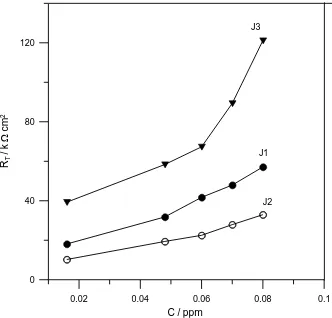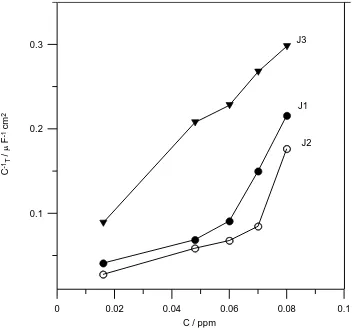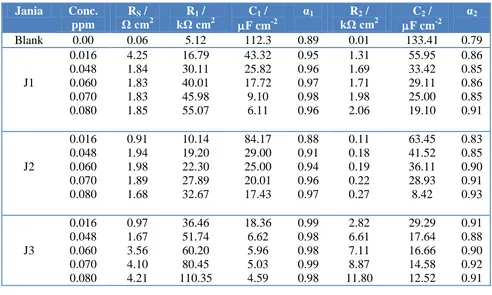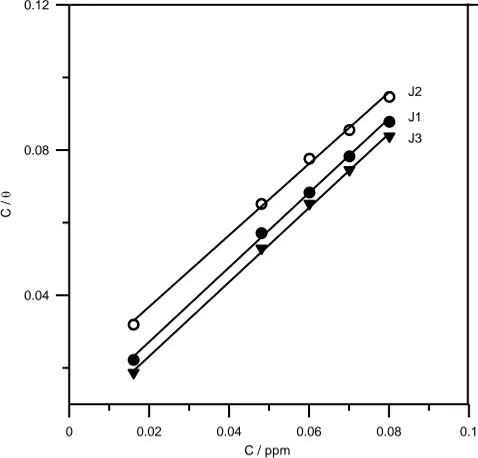Int. J. Electrochem. Sci., 6 (2011) 1572 - 1585
International Journal of
ELECTROCHEMICAL
SCIENCE
www.electrochemsci.orgElectrochemical Behavior of Titanium Alloy in 3.5% NaCl
Containing Natural Product Substances
M. A. Ameer1,*, A.M. Fekry1, S.M.Shanab2
1
Chemistry Department, Faculty of Science, Cairo University, Giza-12613, Egypt.
2
Botany Departments, Faculty of Science, Cairo University, Giza-12613, Egypt.
*
E-mail: mameer_eg@yahoo.com
Received: 13 March 2011 / Accepted: 24 April 2011 / Published: 1 May 2011
Marine environment is a complex corrosive system and presence of red algae is one of the factors that influence corrosion processes. Biofouling is one of the major impediments in the use of titanium in sea-water cooled condensers of power plants, which is otherwise an excellent material with respect to corrosion resistance. Electrochemical impedance spectroscopy (EIS) experiments were carried out in 3.5% NaCl to study the corrosion inhibition effect of red algal extracts on Ti-6Al-4V surfaces. The results indicated that the type of extract, the extract concentration and the immersion time affect the inhibition efficiency (IE%). In general, corrosion rate for J1, J2 and J3 [Successive extractions by hexane (J1), ethyl acetate (J2) and methanol (J3)] decreases with increasing its concentration or immersion time. The order of IE% was found to be J3 ˃ J1 ˃ J2. Langmuir adsorption isotherm was found to fit well the experimental data. Values were calculated for the adsorption process and it is seemed to be in the order of: J3 (365.66 ppm-1) ˃ J1 (150.42 ppm-1) ˃ J2 (58.35 ppm-1). The results were confirmed by Scanning electron microscope (SEM) photos.
Keywords: EIS, red alga, NaCl, SEM, titanium alloy.
1. INTRODUCTION
positive in the presence of Bacillus Subtilis [1]. The term microbiologically influenced corrosion (MIC) is usually interpreted as to indicate an increase in corrosion rates due to the presence of bacteria that accelerate the rates of anodic and/or cathodic corrosion reaction, while leaving the corrosion mechanism more or less unchanged. The possibility of corrosion inhibition caused by microorganisms has rarely been considered [2]. Some researchers have evaluated the concept of corrosion control using regenerative biofilms (CCURB) for a variety of materials such as Al 2024, mild steel and cartridge brass in laboratory tests [3-10]. The chemical and biological activities of the bioactive brominated compounds, nitrogen heterocyclics, nitrogen-sulphur heterocyclics, sterols, terpenoids and sulfated polysaccharides isolated from marine algae, fungi and bacteria have been reviewed [11]. A majority of red algae and almost all the genera of brown algae except Bodanella, Pleurocladia and Heribaudiella occur in salt water. The chemistry of marine natural products has grown normously in the last fifty years. The result is revealed that there is an avalanche of new and biologically exciting marine natural products. However, there is one negative aspect to this work. It is that the isolated compounds are often available in minute amounts. Therefore, if the structure is complex, it is an arduous, and often impossible, task to isolate enough of the natural material for clinical trials.
This is where synthetic chemistry can come to the help of the clinician. Marine natural products are often wonderful challenges to synthetic chemists. The biological activity of an extract of marine organisms or isolated compounds could be assessed in several ways. A fair understanding of biological, toxicological and clinical evaluation is essential to those interested in searching potential drugs from marine organisms. The sulfated polysaccharides obtained from seaweeds are economically the most important products due to their extensive use in food and medicine. Of the four major seaweed classes, the rhodophyceae (red algae), the phaeophyceae (brown algae), the cyanophyceae (blue-green algae) and the chlorophyceae (green algae), the first two classes produce polysaccharides of main interest. The red algae produce carrageenan, agar, agarose, furcellaran or Danish agar. The use of seaweed extracts in food and medicine is reviewed [12]. Marine organisms exhibit a wide range of biological activity [13-15], antioxidant [16], antiviral [17], antibiotic [18], antifungal and antimicrobial activities of marine organisms have been reported [19-24]. The alkaloids are generally defined as naturally occurring basic nitrogenous compounds. Majority of this class of compounds display biological activity.
The reviewers [25-28] of marine alkaloids have, therefore, included amino acids, purines, primidines and their nucleosides, peptides, nitrogenous marine toxins, guanidine etc. under marine alkaloids. In general algae and seaweeds inhabiting different fresh and marine aquatic systems were found to produce different bioactive substances with antimicrobial, antialgal, antiviral, antitumor and anti-inflammatory effects. Algal species belonging to different algal divisions have in addition of their specific pigment contents, different cell wall constituents and produce variable secondary metabolites each has a definite action [29].
performance model sailplane. Titanium posses unique corrosion resistance with protected passive and tenacious oxide film which is generally of TiO2 and can have a composite structure which can include
TiO which is commonly evident in the early stages of formation [30,31]. The corrosion behaviour of Ti-6Al-4V at room temperature has been investigated by a few workers [32,33], the work relating the corrosion behaviour of Ti-6Al-4V with its microstructure and mechanical properties. Historically, Ti alloys have been used in chemical, petrochemical and biomedical applications because of their excellent corrosion resistance and biocompatibility.
The work is concerning to look for biologically active substances from marine red algal extracts against marine corrosive effect on Ti-6Al-4V using EIS technique.
2. MATERIALS AND METHODS
Ti-6Al-4V alloy supplied from Johnson and Matthey (England) with composition (wt%); 5.7 Al, 3.85 V, 0.18 Fe, 0.038 C, 0.106 O and 0.035 N and balance titanium. The coupon was welded to an electrical wire and fixed with Araldite epoxy resin in a glass tube leaving cross-sectional area of the specimen 0.196 cm2.The solution used was 3.5% NaCl solution. All reagents are Analar and the solution is prepared using triply distilled water.
The Rhodoplycean (red) seaweed Jania corniculata was collected from Mediterranean sea at Alexandria (Abu Quir).The alga was carefully cleaned, washed several times with tap water, distilled water, then air dried away from direct sunlight at room temperature, ground and kept in dark, sterilized, labeled jars till use. Successive extractions by hexane (J1), ethyl acetate (J2) and methanol (J3) were carried out. Filtration of extracts was followed by evaporation of organic solvents at room temperature. The residue of each extract was redissolved by the least volume of the same solvent used for extraction in a preweighed vials, followed by evaporation of solvent and reweighed the extract. Different concentrations (0.016, 0.048, 0.06, 0.07 and 0.08 ppm ) were prepared from each extract (J1, J2, J3).
The surface of the test electrode was mechanically polished by emery papers with 400 up to 1000 grit to ensure the same surface roughness, degreasing by acetone, rinsing with ethanol and drying in air. The cell used was a typical three-electrode, one fitted with a large platinum sheet of size 15 x 20 x 2 mm as a counter electrode (CE), saturated calomel (SCE) as a reference electrode (RE) and the alloy as the working electrode (WE).
3. RESULTS AND DISCUSSION
3.1. Effect of concentrations of the three Jania corniculata extracts
ž
Figure 1. (a-c): Bode plots of Ti-6Al-4V alloy in 3.5% NaCl without and with different concentrations of J1, J2 and J3, respectively at 298 K.
In these experiments, Ti-6Al-4V alloy was tested in 3.5% NaCl solution without and with different concentrations of the three Jania corniculata extracts: J1, J2 and J3. The EIS scans as Bode plots at different concentrations are given in Fig.1 (a,b,c) ) for J1, J2 and J3 respectively. It can be seen that these diagrams show resistive regions at high and low frequencies and capacitive contribution at intermediate frequencies. The impedance (|Z|) as well as the phase shift θ for both alloys is clearly found to depend on both the type and concentrations of three Jania corniculata extracts.
Table 1. The three Jania corniculata extracts (Hexane, ethyl acetate and methanol) exhibited different activities.
The active components Solvents
Jania
Carotenoids Oxygenated carotenoids
Fatty acids Sterols Hexane
J1
Chlorophyll Di and triterpenoids Ethyl acetate
J2
Phycobiliprotein Phenolic compounds+++ Sulphated polysaccharides
Alkaloids Methanol
[image:5.596.97.496.75.356.2]
The obtained results, illustrated in Table 1, revealed that the three Jania corniculata extracts (Hexane, ethyl acetate and methanol) exhibited different activities. The polar methalonic extract was shown to be the most promising extract inhibiting metal corrosion followed in descending order by hexane (non polar solvent) and finally by the partially polar acetate extract. It has been shown previously that marine macro algae can inhibit the growth of some bacteria [34] and the efficiency of algal extracts against microorganisms is influenced by factors such as location and seasonality [35,36]. Al 2024 is very susceptible to pitting corrosion in seawater; however, it has been found that a number of microorganisms are able to prevent pitting of Al 2024 in AS. These results suggest that microbiologically induced corrosion inhibition (MICI) is a more common phenomenon than was previously assumed. It has been shown that MICI occurs only in the presence of a live biofilm [10]. This may be due to the synergetic effect of the compounds of J3 are antioxidant and have the ability to scavenge any free radicals present at the surface and decrease the corrosion. J1 also have antioxidant compounds but less than J3 while J2 has the lowest one as shown in Table1.
Figure 2. Equivalent circuit model representing two time constants for an electrode/electrolyte solution interface.
The Bode format of Fig. 1 confirms the presence of two time constants as there are two maximum phase lags appears at medium frequencies (MF), and low frequencies (LF). On the other hand, for the impedance diagrams with two time constants the appropriate equivalent model, shown in Fig. 2, consists of two circuits in series from R1C1 and R2C2 parallel combination and the two are in series
with Rs. In this way C1 is related to contribution from the capacitance of the outer layer and the
faradaic reaction therein and C2 pertains to the inner layer, while R1 and R2 are the respective
resistances of the outer and inner layers constituting the surface film, respectively [37,38]. Analysis of the experimental spectra was made by best fitting to the corresponding equivalent circuit using Thales software provided with the workstation where the dispersion formula suitable to each model was used [39]. In this complex formula an empirical exponent (α) varying between 0 and 1, is introduced to account for the deviation from the ideal capacitive behavior due to surface inhomogeneties, roughness factors and adsorption effects [40]. In all cases, good conformity between theoretical and experimental was obtained for the whole frequency range with an average error of 3%. For this model the electrode impedance is represented by the following transfer function [41]:
Z(ω) =
1
) ( 1 1 1
1
j C R
R Ro
+
2
) (
1 2 2
2
j C R
R
(1)
Rs
C2
R2 R1
[image:6.596.164.420.318.391.2]
The above formula takes into account the deviation from the ideal RC behavior and considers, for a more realistic approach that each oxide layer as non-homogeneous. Thereby, the impedance associated with the capacitance of each layer is described by a constant phase element (CPE). By this way C1 is
related to contributions from the capacitance of the porous (outer) layer and C2 of the barrier inner
layer while R1 is the resistance of the outer porous layer and R2 of the barrier layer [42]. For this
model, the total reciprocal capacitance is given by the well-known relation: 1
2 1 1
1
C C
CT (2)
The estimated theoretical impedance parameters are collected in Table 2 for the tested solutions of various concentrations.
0.02 0.04 0.06 0.08 0.1
C / ppm 0
40 80 120
RT
/
k
c
m
2
J3
J1
J2
Figure 3. Dependence of T
R on the Jania concentrations for Ti-6Al-4V alloys in 3.5% NaCl containing J1, J2 and J3 at 298 K.
Figs. 3 and 4 display the total resistance (RT = R1 + R2) and CT1of the surface film as a function of the Jania concentration, respectively. The results indicate that both RT and CT1increase rapidly with the increase of Jania concentration, and also their values depend on the type of extract. In general the values of 1
T
C and
T
[image:7.596.132.464.284.602.2]
inhibiting species by the biofilm as suggested by Eashwar et al [43] or to a reduction of the chloride concentration at the surface that is covered by the biofilm.
0 0.02 0.04 0.06 0.08 0.1 C / ppm
0.1 0.2 0.3
C
-1 T
/
F
-1
c
m
2
J3
J1
J2
Figure 4. Dependence of 1 T
C on the Jania concentrations for Ti-6Al-4V alloys in 3.5% NaCl containing J1, J2 and J3 at 298 K.
They observed that the impedance for these two materials did not change with time despite formation of a biofilm and suggested that the porous and water-like structure of the biofilm did not produce the characteristic changes in the impedance spectra that result from the application of protective polymer coatings [44]. As also discussed [45], the decrease of the corrosion rate of mild steel in the presence of Shewanella is due to a reduction of the rate of both the anodic and the cathodic reaction. The fairly high values of RT, which approached to 122.15 kΩ cm2 range for J3 at 0.080 ppm,
suggest that pits formed in the initial stages of exposure have become passivated. Very similar results were obtained in the presence of B. subtilis producing polyglutamate or polyaspartate [3-6]. The increased RT values suggest that the inhibitors produced by Jania provided additional corrosion
[image:8.596.123.475.137.466.2]
Table 2. Impedance parameters for Ti-6Al-4V alloy as a function of concentration in 3.5% NaCl containing Jania at 298 K.
Jania Conc. ppm
RS /
Ω cm2
R1 /
kΩ cm2
C1 /
F cm-2
α1 R2 /
kΩ cm2
C2 /
F cm-2
α2
Blank 0.00 0.06 5.12 112.3 0.89 0.01 133.41 0.79
J1 0.016 0.048 0.060 0.070 0.080 4.25 1.84 1.83 1.83 1.85 16.79 30.11 40.01 45.98 55.07 43.32 25.82 17.72 9.10 6.11 0.95 0.96 0.97 0.98 0.96 1.31 1.69 1.71 1.98 2.06 55.95 33.42 29.11 25.00 19.10 0.86 0.85 0.86 0.85 0.91 J2 0.016 0.048 0.060 0.070 0.080 0.91 1.94 1.98 1.89 1.68 10.14 19.20 22.30 27.89 32.67 84.17 29.00 25.00 20.01 17.43 0.88 0.91 0.94 0.96 0.97 0.11 0.18 0.19 0.22 0.27 63.45 41.52 36.11 28.93 8.42 0.83 0.85 0.90 0.91 0.93 J3 0.016 0.048 0.060 0.070 0.080 0.97 1.67 3.56 4.10 4.21 36.46 51.74 60.20 80.45 110.35 18.36 6.62 5.96 5.03 4.59 0.99 0.98 0.98 0.99 0.98 2.82 6.61 7.11 8.87 11.80 29.29 17.64 16.66 14.58 12.52 0.91 0.88 0.90 0.92 0.91
0 0.02 0.04 0.06 0.08 0.1
C / ppm 60 80 100 IE % J1 J2 J3
[image:9.596.52.544.109.404.2] [image:9.596.65.529.115.681.2]
The experimental values are correlated to the theoretical impedance parameters of the equivalent model and listed in Table 2. As given in Table 2, it was found that film healing and thickening ( 1
T
C ) becomes effective by increasing the concentrations of the three extracted jania. This is caused by the formation of adherent corrosion products on the sample surface. As shown in Fig.5, the inhibition efficiency increases with Jania concentration and also it is higher for J3 then J1 and J2 which has the lowest one. At 0.080 ppm it reaches 97% for J3, 90% for J1 and 83% for J2. Such action could be explained through that the polar extract of red alga Jania Coniculata (J3) contains the pigments characteristic of the red algae which is the phycobiliproteins(which include phycocyanin and phycoerythrin) together with the sulphated polysaccharides, as well as large proportions of phenolic compounds and alkaloids. Each of these compounds in the polar extract may have its own inhibitory activity of metal corrosion. Also they may act synergistically leading to large detectable increase in protection against corrosion.
3.2. Effect of immersion time
[image:10.596.96.460.404.667.2]EIS is a useful technique for long time tests, because they don't significantly disturb the system and it is possible to follow it over time [46].
Figure 6. Dependence of T
R on the immersion time for Ti-6Al-4V alloys in 3.5 % NaCl without and with 0.080 ppm of J1, J2 and J3 at 298 K.
Immersion Time / h
0 20 40 60 80 100
RT
/ k
cm
2
0 100 200 300 400 500
J3
J1
J2
The present work was carried out in 3.5% NaCl containing 0.080 ppm of J1, J2 or J3 for 100 hours immersion time. From EIS data, it is obvious that both
T
R and 1 T
C values increased sharply with immersion time as shown in Figs. 6 & 7, respectively. The formation of the inhibitor surface film, and therefore the inhibitor adsorption, on the electrode surface was fast and completed within 50 h for J3. This is consistent with the synergistic effect of inhibitor (due to adsorption) and Ti alloy corrosion products to increase the protective power of the passive film and a compact adsorbed film of the inhibitor is formed on the surface.
0 40 80
Immersion Time/ h 0
0.2 0.4 0.6
CT
-1/
F
-1
c
m
2
Blank J3
J1
[image:11.596.158.443.220.502.2]J2
Figure 7. Dependence of 1 T
C on the immersion time for Ti-6Al-4V alloys in 3.5 % NaCl without and with 0.080 ppm of J1, J2 and J3 at 298 K.
3.3. Adsorption isotherms
With regard to Langmuir adsorption isotherm, Eq. (3), it was found to fit well with the experimental data obtained. Where is the surface coverage (IE %) / 100) of the inhibitor on the Titanium alloy surface which is related to the concentration (C) of the inhibitor in the bulk of solution according to the following equation:
C K C
ads
1
ads
K is the adsorption-desorption equilibrium constant. By plotting C/ versus C at 298K for the three inhibitors, straight lines were obtained as seen in Fig.8. From the intercepts,
ads
K values were calculated for the adsorption process. The equilibrium constant of adsorption is seen to be in the order of: J3 (365.66 ppm-1) ˃ J1 (150.42 ppm-1) ˃ J2 (58.35 ppm-1). The
ads
K values may be taken as a measure of the strength of the adsorption forces between the inhibitor molecules and the metal surface [47]. Therefore, the strongest interaction between the double layer existing at the phase boundary and the adsorbed molecules and the highest IE% are owing to J3.
The surface morphology of Ti alloy was studied by scanning electron microscopy (SEM). Fig. 9(a,b) shows the SEM photograph of Ti-6Al-4V surface without and with 0.080 ppm of J3 after 50 h in 3.5% NaCl. The SEM photographs showed that the surface of metal has corrosion product(a), but in presence of inhibitor(J3) they are minimized on the metal surface(b). It indicates the formation of passive layer on the metal surface. So the corrosion rate is decreased in the presence of Jania (polar extract).
0 0.02 0.04 0.06 0.08 0.1 C / ppm
0.04 0.08 0.12
C
/
J2 J1 J3
Figure 8. Langmuir adsorption isotherm of J1, J2 and J3 on Ti-6Al-4V surface.
a) b)
[image:12.596.178.417.305.534.2] [image:12.596.113.490.587.726.2]
4. CONCLUSIONS
The corrosion inhibition of titanium alloy increases in presence of three different red algal extracts in 3.5% NaCl solution.
The corrosion inhibition in 3.5% NaCl is in the order of: J3 J1 J2.
The total resistance RT and the relative thickness 1
T
C of the film formed on titanium alloy in 3.5% NaCl is in the order of : J3 J1 J2.
The corrosion of titanium alloy in 3.5% NaCl can be effectively inhibited by addition of Jania extract and increasing with concentration, this was confirmed by SEM images.
References
1. F.Mansfeld , Electrochim. Acta , 52(2007)7670-7680. 2. H.Videla , Manual of Biocorrosion, (1996) CRC Press. 3. C.Homero , X. Benetton , Corros.Sci., 50(2008)1169-1183.
4. F.Mansfeld ,C.Hsu,D.Ornek , T.Wood,B.Syrett, Electrochem.Soc., 149(2002)B130-B138. 5. D.Örnek , A.Jayaraman,T.Wood , Z.Sun,C.Hsu, F.Mansfeld , Corros.Sci,. 43(2001)2121-2133. 6. F. Barragán, R. Guardián, C. Menchaca, I. Rosales, J. Uruchurtu, Int. J. Electrochem. Sci., 5
(2010) 1799 - 1809.
7. I.E. Castañeda, J.G. Gonzalez-Rodriguez, G. Dominguez-Patiño, R. Sandoval-Jabalera, M.A.Neri-Flores, JG. Chacon-Nava1, A. Martinez-Villafañe, Int. J. Electrochem. Sci., 6 (2011) 404 - 418 8. D.Örnek , A. Jayaraman , B.Syret, C. Hsu, F.Mansfeld , T.Wood, Appl. Microbiol. Biotechnology,
58(2002)651-657.
9. D.Örnek , T.Wood,C. Hsu , F.Mansfeld, Corros. Sci ,.44(2002)2291-2302. 10.A.Nagiub , F.Mansfeld, Electrochim. Acta, 47(2002)2319-2333.
11.D.Rawat, Bioactive Marine Natural Products . Bhakuni Central Drug Research Institute Lucknow, IndiaCopyright , Anamaya Publishers, New Delhi, India,2005.
12.S.Upham, Drugs from Sea (edited by H. D. Freudenthal) Marine Technology Society, Washington D.C.,1968, pp. 291.
13.R.Brown , T.Galloway , D. Lowe, M. Browne, A.Dissanayake , M.Jones , M.Depledge , Aquat. Toxicol, 66(2004) 267-278.
14.L.Xiong , J.Li, F.Kong, Lett. Appl. Microbiol, 38(2004) 32-37. 15.V.Wilsanand , A. Wagh , M. Bapuji, Microbios, (2001) 41-50. 16.S.Shanab , Int. J. Agri. Biol., 9(2007) 220-225.
17.K.Gustafson, N.Oku , D. Milanowski, Curr. Med. Chem. Anti-Infective Agents, 3(2004) 233-249. 18.A.Grein , S. Meyer, Bact., 76(1958)457-463.
19.C.Osterhage, R.Kaminsky, G. Konig, A. Wright, Org. Chem., 65(2000) 6412-6417. 20.D.Savoia ,C. Avanzini , T.Allice , E.Callone , G.Guella , F. Dini, Antimicrob and Agents
Chemother, 48(2004)3828-3833.
21.I.Shin , H.Masuda, K. Naohide, Int. J.Food Microbiol, 94(2004) 255-261. 22.W.Pan, X.Liu, F.Ge , J.Han, T. Zheng, Biochem. (Tokyo), 135(2004) 297-304.
23.R.Schumacher, S. Talmage , S. Miller, K. Sarris, B. Davidson,A. Goldberg, Nat J. Prod., 66(2003)1291-1293.
24.Y.Torres, R. Berlinck,G. Nascimento, R.Fortie, C.Pessoa,M. DeMoraes, Arenosclera brasiliensis.Toxicon, 40(2002)885-891.
26.W.Fenical, Alkaloids; Chemical and Biological Perceptives: (edited by Pelletier SW) John Wiley and Sons, N.Y., 4(1986) pp. 275.
27.J.Kobayashi, M.Ishibashi, Alkaloids: Chemistry and Pharmacology, (edited by A. Brossi and G. A. Cordell), Academic Press, San Diego.41(1992) pp. 41.
28.J.Wrobel, K.Wojtassiewicz, Alkaloids: Chemistry and Pharmacology, (edited by Cardell JA), Academic Press., San Diego. 42(1992) pp. 249.
29.D.Lide, CRC Handbook of Chemistry and Physics (86th ed.), Boca Raton (FL): CRC Press,ed., (2005) ISBN 0-8493-0486-5.
30.J.Pouilleau ,D.Diveillers D, F. Garido ,S. Durand-vidal, Mahe,Mater.Sci.Eng., B47(1997)235-243. 31.K.Azumi , N.Yasui , M.Seo , Corros.Sci., 42(2000) 885-896.
32.S.Yerramareddy, S.Bahadur, Wear, 142(1991) 253-263.
33.J.Massoud, G.Coquerelle , M. Collin, Particle erosion behaviour of laser surface treated Ti-6Al4V. in J.E. Field and J.P. Dear (eds.), Erosion by Liquid and Solid Impact, Proc. 7th Int. Co@
Cambridge, UK, Cavendish Laboratory, University of Cambridge, (1987) pp. 53-l-53-7. 34.C. Febles , A. Arias , M.Gil-Rodriguez , A.Hardisson , A.Sierra Lopez, Anuario del Instituto de
Estudios Canarios.,34(1995) 181–192.
35.V.Sastry , G.Rao, Bot Marina., 37(1994)357–360.
36.G.Del Val ,A. Platas, A. Basilio, Int Microbiol, 4(2001)35–40. 37.M.Ameer , A.Fekry , A. Ghoneim ,Corros., 65(2009)587-595.
38.G.Wu,Y. Fan,A. Atrens, C.Zhai, W. Ding, Appl. Electrochem. , 38(2008)251-257. 39.A.Fekry , A. Gasser, M. Ameer, Appl Electrochem., 40(2010)739-747.
40.M.Ameer, A.Fekry, A.Ghoneim, F.Attaby, Int. J. Electrochem. Sci., 5(2010)1847-1861. 41.F.Mansfeld, Electrochim. Acta, 38(1993)1891-1897.
42.M.Eashwar,S. Maruthamutu, K. Sathyanarayanan, K. Balakrishnan, Proceedings of the 12th International Corrosion Congress. 5b, Houston, TX, NACE., (1993) pp. 3708.
43.F.Mansfeld, Appl. Electrochem,. 25(1995) 187-202.
44.M.Dubiel, C.Chien , C.Hsu,F. Mansfeld,D. Newman, Appl.Environ. Mirobiol., 68(2002)1440-1445.
45.D.Marijan ,M. Gojic, Appl. Electrochem., 32(2002)1341-1346. 46.M.Amin, Appl.Electrochem., 36(2006)215-226







